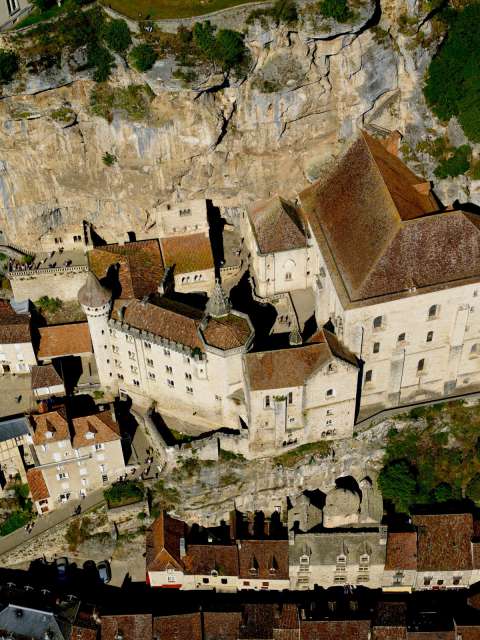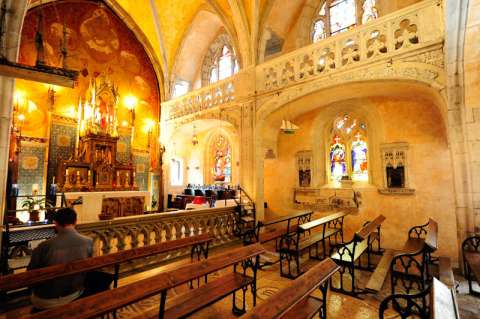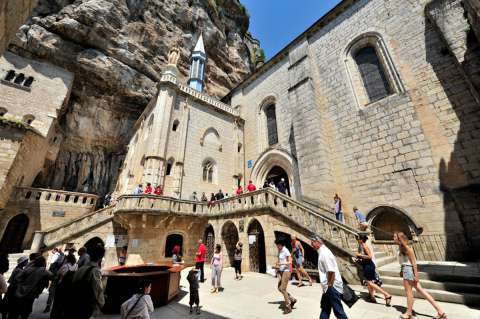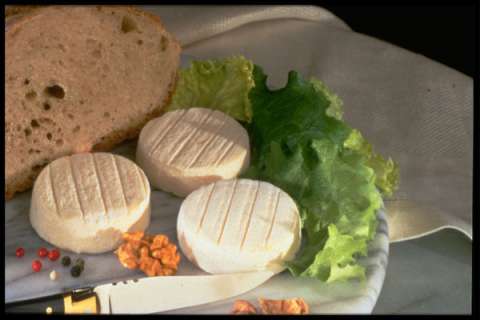The sacred city
Seemingly defying the laws of physics, built against a cliff in the heart of the Dordogne Valley, the sacred city has been spectacularly suspended between Heaven and Earth for a millennium. The basilica Saint-Sauveur and the crypt Saint-Amadour are both listed as UNESCO World Heritage Sites.
History
Rocamadour was already inhabited thousands of years ago as seen in the prehistoric drawings in the Cave des Merveilles.
The Blessed Virgin Mary was worshipped here from the 9th century but the fame of Rocamadour began with a fortuitous discovery in 1166: a body in a perfect state of conservation. Some people think it to be the remains of the disciple Zaccheus, others believe it belongs to Saint Amadour, a hermit who lived inside the caves. In any case, the miracle propelled Rocamadour to become one of the four pillars of Christendom in the Middle-Ages, on a par with Jerusalem, Compostela and Rome. A black wooden statue, found alongside the body, has been linked to many subsequent miracles. Thousands of pilgrims have since made the journey to worship the Black Madonna statue of Rocamadour, including many kings and queens such as Saint Louis, Blanche de Castille and Henry II Plantagenet, father of Richard the Lionheart.
The Sanctuary of Rocamadour was partly burned down in 1562 by the Protestants during the Wars of Religion. Inhabitants managed to save some of the remains of Saint Amadour which were reinstated inside the basilica in 2016.
Cultural Heritage
Dramatically set against a cliff on the limestone plateaus of the Causse du Quercy Natural Regional Park, the Sanctuary of Rocamadour boasts seven chapels. As pilgrims started to flock in the 12th century, the ambitious project of building a church against the rock got under way in 1152. The body of Saint Amadour was on display there until the site got badly damaged by the Protestants in 1562.
Threatening to collapse, Rocamadour was rebuilt in the 19th century under the supervision of the Abbot Chevalt, architect and pupil of Eugène Viollet-le-Duc. Both the Saint-Sauveur basilica and the Saint Amadour crypt are listed as UNESCO World Heritage Sites.
Our Lady of Rocamadour – The statue of the Black Madonna
The statue worshipped since the 12th century is linked to many miracles, often at sea. Hence the many ex-votos of ships hanging in the Notre-Dame chapel. Also hanging from the ceiling, a bell is said to spontaneously toll every time a miracle happens.
The sword named Durandal
Above the chapel of Notre-Dame, a large sword is implanted in the rock. It is said to be the sword of Roland, nephew of king Charlemagne. The brave knight, badly injured on the battlefield in the Pyrenees, implored the Archangel Saint Michael to save his sword from the enemy. He then threw the sword that miraculously flew 300 km to land in the rock face in Rocamadour.
Message and Pilgrimage
The pilgrimage starts in the hamlet of L’Hospitalet, just above Rocamadour. The chapel and the ruins there used to welcome tired travelers in the 13th century. From L’Hospitalet, visitors take the Holy Way to the city of Rocamadour. 216 steps (or a lift) will take you up to the Sanctuary and the seven chapels. The pilgrimage ends in the Chapelle Notre-Dame, where the Black Madonna statue awaits visitors hoping for a miracle, a cure or protection.
Sightseeing
The Sanctuary and medieval city
The breath-taking site of Rocamadour at the heart of the Dordogne Valley: « Houses above a stream, churches above the houses, rocks above the churches, a castle above the rocks”.
Guided tours also available, including fun tours for kids.
Le Rocher des Aigles Eco-park
Vultures, condors, eagles, rare bird species flying free above the canyon in a spectacular and educational show.
Monkey Park - La Forêt des Singes
130 Barbary macaque monkeys roaming free in an oak forest. You can get close to them and even feed them.
Spectacle Durandal - Medieval stunt show on horseback
Including the battle between two legendary swords: Excalibur vs Durandal
Prehistoric cave - La Grotte préhistorique des Merveilles
Original prehistoric paintings dating back 20 000 years. Easy access involving a few steps.
Goat farm - La chèvrerie de la Borie d’Imbert
The famous Rocamadour goats’ cheese has been a local delicacy since the 15th century. Come and try its creamy texture and see how it is made. Baby animal farm on site, great for kids.
Delicious farm produce - La Ferme des Campagnes
The Dordogne Valley is famous worldwide for its cuisine. Once you have tasted the Rocamadour goats’ cheese, try other local specialties straight from the farm: duck, duck breast, foie gras…All the animals are raised free range.
Lavender distillery - La Ferme des Alix
Lavender has been grown here for centuries. Local essential oils, honey and artisanal lavender soaps.
Hiking in and around Rocamadour
Situated on the Road to Compostela, Rocamadour also boasts many smaller hiking tracks, accessible to all the family, to discover the natural riches of the Dordogne Valley.
Events
May / June
Fête des fromages – Cheese festival
Each Pentecost Sunday, a huge cheese festival with cheese from all over France as well as the famous local delicacy: the Rocamadour goats’ cheese.
July
Medieval festival - Les Médiévales de Rocamadour
Wind back the clock to medieval times with costumes, shows and entertainment. At night the city of Rocamadour is firelit during a captivating light show.
July / August
Festival de Rocamadour
Three weeks of sacred classical music inside the basilica including visiting performances from leading European classical artists. Unmissable.
September
Hot-air balloon festival - Les Montgolfiades
On the last week-end of September, 30 hot-air balloons from all over Europe take off in front of the medieval city of Rocamadour for an amazing feast of flights.
To find out more about visiting and staying in Rocamadour: www.visit-dordogne-valley.co.uk








